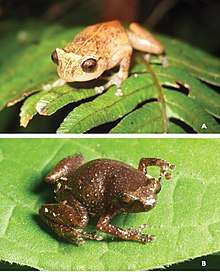Aphantophryne nana
Aphantophryne nana is a species of frog in the family Microhylidae. It is endemic to the Philippines and is known with certainty only from the island of Camiguin.[2][3] It is unclear whether similar frogs from northeast Mindanao are referable to this species.[1] It was described as Oreophryne nana, but based on molecular data it was moved to Aphantophryne in 2017.[3][5] Common names Camiguin cross frog,[2] Camiguin narrow-mouthed frog,[6] and volcano cross frog have been coined for the species.[3]
| Aphantophryne nana | |
|---|---|
 | |
| Aphantophryne cf. nana males from Mindanao: it is uncertain whether these specimens belong to Aphantophryne nana.[1] | |
| Scientific classification | |
| Kingdom: | Animalia |
| Phylum: | Chordata |
| Class: | Amphibia |
| Order: | Anura |
| Family: | Microhylidae |
| Genus: | Aphantophryne |
| Species: | A. nana |
| Binomial name | |
| Aphantophryne nana (Brown and Alcala, 1967) | |
| Synonyms[3] | |
|
Oreophryne nana Brown and Alcala, 1967[4] | |
Description
Aphantophryne nana are small, moderately slender-bodied frogs. Adult females in the type series measure 17–20 mm (0.7–0.8 in) in snout–vent length; no males were collected. The head is broader than it is long. The snout is short and bluntly round–pointed. The canthus rostralis is rounded. The tympanum is distinct. The fingers and the toes are dilated into moderately large disks (with the exception of the first finger). Skin is smooth. Preserved specimens are dusky brown, apart from the blackish snout, upper eyelids, and axillary and loreal regions.[4]
Aphantophryne nana differs from Aphantophryne anulata by the absence of subarticular tubercles on the hand, but the diagnostic value of this character has been questioned because specimens from Mindanao show a variable degree of distinctiveness for this trait.[1]
Habitat and conservation
Aphantophryne nana occurs in mossy and montane rainforests.[2] The types were collected in dipterocarp forest at elevations between 550 and 910 m (1,800 and 3,000 ft) above sea level.[4] Eggs presumably belonging to this species have been found under mosses. Development is direct, without a free-living tadpole stage.[2]
Aphantophryne nana is rare on Camiguin. Shifting agriculture and illegal logging threaten its habitat at lower altitudes.[2]
References
- Sanguila, Marites B.; Cobb, Kerry A.; Siler, Cameron D.; Diesmos, Arvin C.; Alcala, Angel C. & Brown, Rafe M. (2016). "The amphibians and reptiles of Mindanao Island, southern Philippines, II: the herpetofauna of northeast Mindanao and adjacent islands". ZooKeys (624): 1–132. doi:10.3897/zookeys.624.9814. PMC 5096358. PMID 27833422.
- IUCN SSC Amphibian Specialist Group. 2018. Oreophryne nana. The IUCN Red List of Threatened Species 2018: e.T26210A58475302. https://dx.doi.org/10.2305/IUCN.UK.2018-1.RLTS.T26210A58475302.en. Downloaded on 22 December 2018.
- Frost, Darrel R. (2018). "Aphantophryne nana (Brown and Alcala, 1967)". Amphibian Species of the World: an Online Reference. Version 6.0. American Museum of Natural History. Retrieved 9 April 2018.
- Brown, Walter C. & Alcala, Angel C. (1967). "A new frog of the genus Oreophryne and a list of amphibians from Camiguin Island, Philippines". Proceedings of the Biological Society of Washington. 80: 65–68.
- Rivera, Julio A; Kraus, Fred; Allison, Allen & Butler, Marguerite A. (2017). "Molecular phylogenetics and dating of the problematic New Guinea microhylid frogs (Amphibia: Anura) reveals elevated speciation rates and need for taxonomic reclassification". Molecular Phylogenetics and Evolution. 112: 1–11. doi:10.1016/j.ympev.2017.04.008. PMID 28412536.
- "Oreophryne nana Camiguin Narrow-mouthed Frog". Encyclopedia of Life. Retrieved 9 April 2018.
